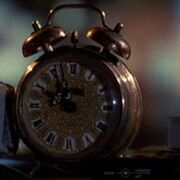
The alarm clock placed inside the DeLorean.
Clocks were a primary focus of Emmett Brown's studies in time travel and physics. He had almost thirty synchronized clocks in his residence in 1985. Due to a time delaying experiment, all but one became 25 minutes slow [1]. Doc also used two synchronized, LED-display chronometers during the world's first temporal displacement. These had been set to display the hour and the minute only, rather than as a stopwatch [2]. Doc retained one chronometer while the other was hung around Einstein's collar. While the two clocks were in complete synchronization before the trip, Einstein's clock was "exactly one minute behind" afterward.
The clock on the Hill Valley Courthouse became the key to Marty's return to 1985, because it recorded the time and place where lightning would strike, as well as the source for sufficient energy to power the time circuits on the DeLorean time machine to 1985 after being struck by lightning.
Doc's fascination with clocks led, indirectly, to his discovery of how to travel through time. As Doc related to Marty in 1985, he had been "standing on the edge of my toilet, hanging a clock" when he slipped and struck his head, awakening with a vision of the flux capacitor.
Marty wore a wristwatch that never seemed to work [3] , although the alarm went off in Lou's Cafe. [4]
Doc placed a brass alarm clock on the dashboard of the DeLorean which he set to go off when it was time for Marty to drive toward the lightning bolt at the clock tower. In 1955, Doc wore three watches -- one on the back of his left wrist, one on the front of his right wrist, and a pocket watch. In 1885, Doc wore a pocket watch that Buford borrowed to count down the time for Marty to appear for their duel.
The time circuits of the DeLorean had a built-in clock that kept track of the local time that had been visited, and would adjust for any new time period entered.
Behind the scenes
One of the recurring themes in Back to the Future was the moving forward of clocks, whether by the advancement of the minute hand on an "analog" clock, the changing of a number on a digital clock, or the sounding of a bell or alarm as a time has been reached. When a clock was shown in the film, it was likely that the time would soon change:
- The clock radio in Marty's bedroom went from 12:27 to 12:28 a moment before the phone rang.
- The clock at Twin Pines Mall changed from 1:15 to 1:16 as Marty arrived.
- Doc and Einstein's LED stopwatches advanced from 1:18 to 1:19 to prove that they were synchronized. After Temporal Experiment #1, Doc displayed his stopwatch advancing from 1:21 to 1:22 while Einstein's was shown to be still ticking and exactly one minute slow.
- The clock on the Clock Tower sounded at 8:30 as Marty walked into town.
- The minute hand on the Clock Tower advanced from 10:03 to 10:04, a moment before the lightning bolt struck.
- The clock on the Bank of America advanced from 1:13 to 1:14 when Marty returned to 1985.
- The clock radio in Marty's room advanced from 10:27 to 10:28, causing the radio to come on.
Notes
- ↑ The clock with the correct time can be glimpsed as Marty's skateboard glides to a stop at the case of plutonium. The clock is leaning against Doc's bed, and its hands show the time to be slightly past 8:20
- ↑ In commentary on the DVD for Part I, Bob Gale recalled that it "was a pain in the ass... to have both clocks to change at the exact same moment"
- ↑ Marty can be seen shaking and listening to his wristwatch, as if to see whether it is still "ticking".
- ↑ The beeping alarm sounded a little more than two and a half hours after Marty's departure (at 1:30 a.m.) from 1985. Whether Marty intended for it to or not, the watch's alarm would have awakened him at 4 in the morning if he had stayed in bed.
